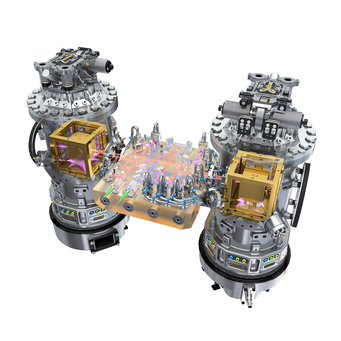LISA Pathfinder exceeds expectations
The perfect free fall in space with key contributions from Hannover researchers
The ESA satellite mission LISA Pathfinder has successfully demonstrated the technology for a gravitational wave observatory in space such as LISA.
After a picture perfect start, a journey to its destination some 1.5 million kilometers from Earth towards the Sun, and a successful release of the test masses, LISA Pathfinder began its job as a space laboratory on 1 March. Now scientists presented the results form the first two months of operations.
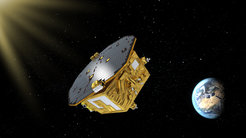
“With LISA Pathfinder we have created the quietest place known to humankind. Its performance is spectacular and exceeds all our expectations by far,” says Prof. Karsten Danzmann, director at the Max Planck Institute for Gravitational Physics (Albert Einstein Institute, AEI) and director of the Institute for Gravitational Physics at Leibniz Universität Hannover, who also is the Co-Principal Investigator of the LISA Technology Package. “Only by reducing and eliminating all other sources of disturbance we could observe the most perfect free fall ever created. And this has shown us that we can build LISA, a space-based gravitational-wave observatory.”
The results show that the two test masses at the heart of the spacecraft are falling freely through space under the influence of gravity alone. They are unperturbed by other external forces, to a precision more than five times better than originally required.
The LISA Pathfinder team presents the results in a paper published today in Physical Review Letters. Among the authors are 20 researchers from Albert Einstein Institute and Leibniz Universität Hannover. The team shows that the test masses are almost motionless with respect to each other, with a relative acceleration lower than 1 part in ten millionths of a billionth of Earth's gravitational acceleration. This corresponds to the weight of a virus on Earth.
The successful demonstration of the mission’s key technologies opens the door to the development of a large space observatory capable of detecting gravitational waves emanating from a wide range of exotic objects in the Universe.
Gravitational-wave detection in space
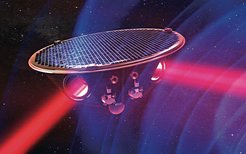
Einstein predicted gravitational waves from his theory of general relativity. They were – 100 years after their prediction by Albert Einstein – measured for the first time by the ground-based Advanced LIGO detectors in September 2015. Space-borne observatories such as LISA will complement the existing ground-based detectors by measuring low-frequency gravitational waves inaccessible on the Earth.
The signals seen by LIGO have frequencies between 10 Hz and several 1000 Hz, but gravitational waves span a much broader spectrum. In particular, lower frequency waves are produced by exotic events such as the mergers of supermassive black holes from Galaxy collisions.
Detecting the gravitational waves emitted from these events at low frequencies between 0.1 mHz and 1 Hz requires measuring tiny fluctuations in distance between objects placed millions of kilometres apart. This can only be achieved in space, where an observatory would also be free of the seismic, thermal, and terrestrial gravity noises that limit ground-based detectors.
LISA Pathfinder was designed to demonstrate key technologies needed to build such an observatory – and is has proven those technologies beyond any doubt. It is an ESA mission, with the European space industry under the overall integration responsibility of Airbus DS and research institutions from France, Germany, Italy, the Netherlands, Spain, Switzerland and Great Britain as well as NASA participating.
The Albert Einstein Institute and the Institute for Gravitational Physics at Leibniz Universität Hannover are responsible for and coordinate the German contribution to the mission.
“LISA Pathfinder is an absolutely remarkable mission. It achieved something you don't see in every groundbreaking scientific project. It not only met the requirements, but actually surpassed them by far,” says Dr. Jens Reiche, National Project Manager for the LISA Pathfinder Technology Package at the Albert Einstein Institute and Leibniz Universität Hannover.
Successful technology demonstration by LISA Pathfinder
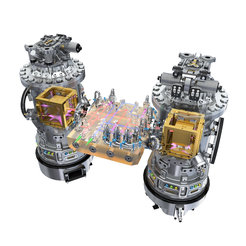
LISA Pathfinder was launched on 3 December 2015, reaching its operational orbit roughly 1.5 million km from Earth towards the Sun in late January 2016. The mission started operations on 1 March. Scientists performed a series of experiments to demonstrate key technologies for space-based gravitational-wave observatories like LISA.
A crucial part of these experiments is placing two test masses in freefall, monitoring their relative positions as they move under the effect of gravity alone. Even in space this is very difficult, as several forces – including the solar wind and pressure from sunlight – continually disturb the test masses and the spacecraft.
Thus, in LISA Pathfinder, a pair of identical, 2-kg, 46-mm gold-platinum cubes, separated by only 38 cm, fly, surrounded, but untouched, by a spacecraft whose job is to shield the cubes from external influences, adjusting its position constantly to avoid hitting them.
Precise measurements with laser interferometry
Between the two test masses, is a laser interferometer which measures the test masses' positions and orientations relative to one another and to the satellite. The construction of the precise optical measurement system was led by scientists of the Max Planck and Leibniz Universität researchers in Hannover.
“The measurements done by this first laser intereferometer in space are by far better than we had expected. We can determine the distance of the two free falling test masses to less than the diameter of a single atom,” says Apl. Prof. Gerhard Heinzel, leader of the research group Interferometry in Space at the Albert Einstein Institute and Leibniz Universität Hannover.
Data analysis in Hannover
During the entire operations phase, Max Planck and Leibniz Universität researchers in Hannover are partners in the data analysis which plays a central role in extracting the crucial information from the science data. They have played a leading role in the development of the software used, too. The institute has set up an operations control room in Hannover to serve for in-depth studies of the data and as back-up for the control room at the European Space Operations Centre (ESOC) in Darmstadt. Since an immediate data analysis is required for the configuration of follow-up experiments, scientist from the institute also take part in the mission operations shifts at ESOC.
“We were absolutely thrilled when within just one day we reached our self-set goal. And now we know that the performance of the laser interferometer has surpassed the level of precision required by a future gravitational-wave observatory by a factor of more than one hundred,” says Dr. Martin Hewitson, LISA Pathfinder Senior Scientist from the Albert Einstein Institute and Leibniz Universität Hannover, who led the development of the data analysis software LTPDA.
”Scientists in Lower Saxony play an important role in this mission. Networking research at universities and outside universities has created an excellent environment for this newest and outstanding success. This makes this mission an important signal for Lower Saxony as a location for science,“ says Andrea Hoops, Secretary of State in the Lower Saxonian Ministry for Science and Culture.
The path to LISA
The measurements and the data analysis show that the test masses are almost motionless and they have also identified, with unprecedented precision, most of the remaining miniscule forces disturbing them (see details in the background information).
The extraordinary results show that the control achieved over the test masses is essentially at the level required to implement a gravitational wave observatory in space. They demonstrate that LISA Pathfinder has proven the key technologies and paved the way for such an observatory like LISA, to be implemented as the third “Large-class” (L3) mission in ESA’s Cosmic Vision programme.
“At the precision reached by LISA Pathfinder, a full-scale gravitational wave observatory in space like LISA would be able to detect fluctuations caused by the mergers of supermassive black holes in galaxies anywhere in the Universe,” says Karsten Danzmann.
Background information
The next steps
The scientific mission of LISA Pathfinder started on 1 March, with a review of the commissioning period presented on 7 March. The science operations will last six months, split between 90 days for the LISA Technology Package, and 90 days for the Disturbance Reduction System, an additional experiment provided by NASA's Jet Propulsion Laboratory.
The call for mission concepts for ESA's L3 mission is expected later this year, and the final decision by early 2020.
Max Planck and Leibniz Universität researchers in Hannover are leading partners in research and development of the LISA mission, which is coordinated within an international consortium.
Detailed information on the measurement results
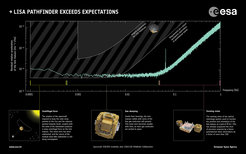
The first two months of data show that, in the frequency range between 60 mHz and 1 Hz, LISA Pathfinder's precision is only determined by the sensing noise of the optical metrology system used to monitor the position and orientation of the test masses.
At lower frequencies between 1–60 mHz, control over the test masses is determined by gas molecules bouncing off the cubes: a small number of them remain in the vacuum surrounding them. This effect was seen getting smaller as more molecules were vented into space, and is expected to improve further in the following months.
At even lower frequencies below 1 mHz, the scientists measured a small centrifugal force acting on the cubes, due to a combination of the shape of LISA Pathfinder’s orbit and to the effect of the noise in the signal of the star trackers used to orient it.
While this centrifugal force slightly disturbs the motion of the test masses in LISA Pathfinder, it would not be an issue for a future space observatory like LISA, in which each test mass would be housed in its own spacecraft, and linked to the others over millions of kilometres via lasers. Similarly, the effects from remaining gas molecules would be far less because of the much longer mission duration.
Funding information
LPF is an ESA mission, with the European space industry under the overall integration responsibility of Airbus DS and research institutions from France, Germany, Italy, the Netherlands, Spain, Switzerland and Great Britain as well as NASA participating.
LPF is funded through the German Aerospace Center (Deutsches Zentrum für Luft- und Raumfahrt; DLR) by the Federal Ministry for Economic Affairs and Energy based on a resolution of the German Bundestag.


